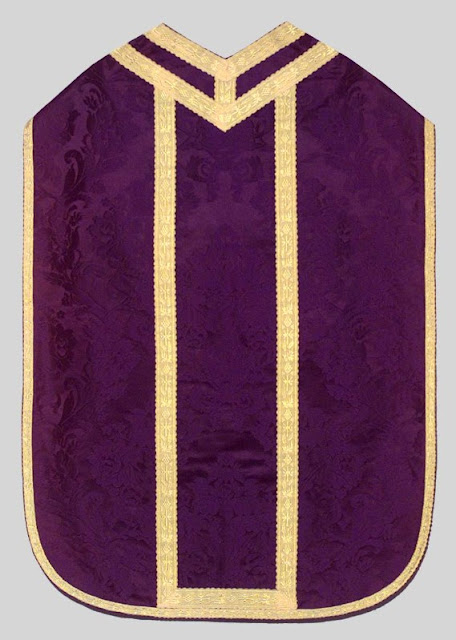In the realm of sacred architecture these unfortunate trends are fortunately now being reversed, and so too are we seeing newer generations of clergy, those who did not have their formative years situated in the 1960's, 70's and 80's (times when this desire for faux primitivism was at its strongest, to the point of becoming a near absolute) restoring to use a more classic approach to sacred vestment work -- which is what our focus is here today. Of course, as part of this there is another concurrent temptation that must be equally avoided, and it is one we have spoken to here before, and that is to avoid overdoing it for there is a distinctive difference between an elegant, richly ornamental vestment and a merely "flashy" one; the former is counter-reformation Rome whereas the latter is merely Las Vegas.
When properly expressed, however, this movement toward reclaiming a greater classic ornamentality in sacred vestments is very encouraging, but it must also be said that there is still also a place for "simpler" designs in vestments so long as we learn from the mistakes of the second half of the twentieth century, avoiding faux primitivism and taking our cues from the classical tradition. In fact, every parish and community should have both types in my estimation, for if we always have the one and the same visual diet of vestment style, they tend to lose their respective liturgical impact. For example, if every vestment in the sacristy looks practically festal, how do we distinguish feast from fast, Sunday from weekday? Concurrently, if every vestment looks practically Lenten and ferial in its sobriety, how do we visually distinguish feria from feast? Variety matters.
But how simpler designs are approached is also important, starting with the materials used in their design. A noble material can go along way, as well as a few decorative accents. Take for example this dalmatic/tunicle seen in Rome in the mid-twentieth century, made from a cream silk damask fabric, which has been delicately accented with a patterned geometric embroidered orphrey, as well as a secondary accented fabric in a renaissance style (seen on the end of the maniple) and completed also with renaissance style tassels. The end result is very dignified and certainly can be characterized as yet another instance of "Romanitas:"
Context is also important. What might work well within a monastic context, for example, is one thing, but that is not always the best model to always follow in parishes, shrines, never mind cathedrals. For example, these very austere monastic chasubles below seem well suited to monastic traditions such as the Carthusians or Cistercians, and I'd point out that what they lack in textile sophistication is made up for by the fuller conical shape with the resulting play of light and shadow on the folds of the arms.
Contextually, the liturgical time can also make a difference. Such simple designs seem best utilized for violet and black times, especially during the weekdays, which naturally tend toward a greater sobriety and in that regard, if something less ornamental than a silk damask is desired, a raw silk would seem particularly well suited. Of course, strictly there is no such necessity, but it is certainly an option.
Here are some other, simple designs, which are I think are more broadly applicable to any liturgical context. They all share the common trait of utilizing a simple but beautiful silk that is then further accented by orphreys that are colourful as well as geometrical.
So then, when we're approaching simpler styles and designs for vestments, let's still make sure they are characterized by quality, nobility and beauty.




















